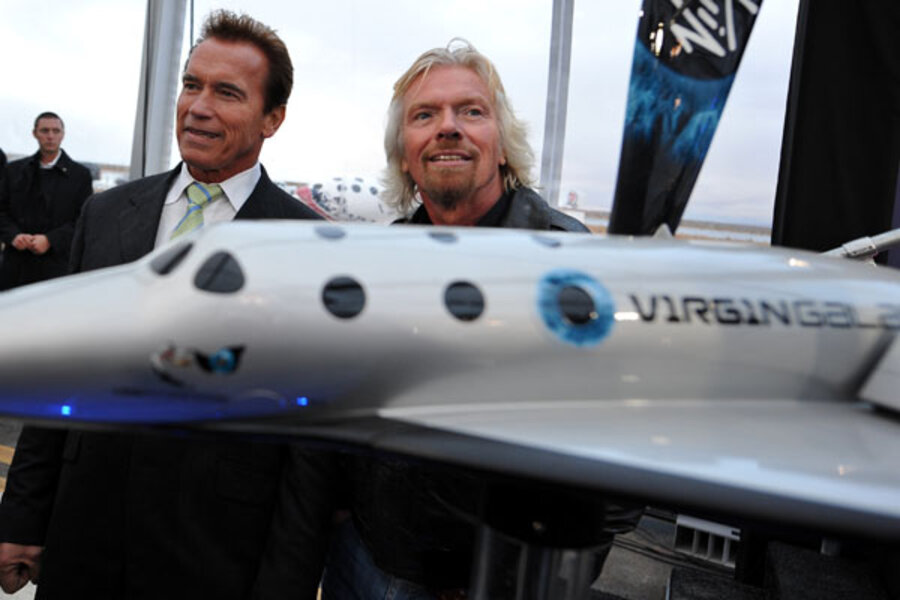Virgin Galatic 'spaceliner' passes another glide test
Chalk up another successful gliding test flight for SpaceShipTwo, Virgin Galactic's commercial spaceliner built to fly paying passengers on suborbital thrill rides.
The privately built suborbital spacecraft was released yesterday (Nov. 17) from its mothership — the WhiteKnightTwo — for the third time for a test flight high above the Mojave Air and Space Port in California.
This latest glide test involved the piloting skills of Pete Siebold, along with co-pilot Clint Nichols. [Gallery: SpaceShipTwo's 1st Solo Test Flight]
IN PICTURES: NASA's Future of Space Exploration
According to a test log posted by Scaled Composites — builder of the WhiteKnightTwo/SpaceShipTwo launch system — a series of flight objectives was successfully met following clean release of the craft at altitude.
"Watching SpaceShipTwo going through its test points, circling the field and landing is thrilling indeed, especially due to the sweeping graceful planform of its wing and boom tails," said Scaled's chief technical officer Burt Rutan, the veteran aerospace designer who founded the company in 1982.
SpaceShipTwo, named the VSS Enterprise, is designed to carry six ticket-holding passengers and two pilots. The undertaking is backed by U.K. billionaire and adventurer Richard Branson for his spaceline, Virgin Galactic.
Suborbital treks are selling at $200,000 a seat, with over 340 individuals signed up for flights to the edge of space.
Aggressive test flight
For its latest glide flight, SpaceShipTwo was flown to a more aggressive stall indication, with the vehicle maneuvered to a 3.5-G level.
During the glide, the craft's stability and control were also evaluated. The space plane was outfitted with a water ballast tank to establish an aft center of gravity.
This third shakeout of the SpaceShipTwo follows the Oct. 10 and Oct. 28 glide flights — each pushing the vehicle to new levels of testing while enhancing pilot proficiency.
SpaceShipTwo builds on the success of Scaled's SpaceShipOne vehicle, a piloted spacecraft that won the $10 million Ansari X Prize in 2004 for reusable suborbital spaceflight.
"Since it is a much bigger spaceship than SpaceShipOne, it gives a visual impression that it is flying a lot slower than the small spaceship," Rutan told SPACE.com. "Yesterday's flight included opening up a much larger portion of the previous envelope, this time using water ballast to achieve an aft center of gravity. The ship dumped the water directly over the field, giving an impression that it was making thrust with the large plume."
Rutan said the flying qualities of the vehicle continue to be reported as excellent.
"Congratulations go to Jim Tighe and his design team, who have done an excellent job on the configuration and aerodynamic details," Rutan said. "It is not easy to achieve good flying qualities on a large aircraft — spacecraft — that uses a reversible flight control system, and Jim did indeed achieve success, right out of the box."
Powered flight ahead
The pace is picking up in assessing SpaceShipTwo as it heads for powered flights using its hybrid rocket engine.
Meanwhile, earlier this month, ceremonies at the Mojave Air and Space Port marked the start of construction of a new facility to build a fleet of SpaceShipTwos and WhiteKnightTwos for Virgin Galactic.
On Nov. 9, The Spaceship Company (TSC) broke ground for its new final assembly, integration and test hangar.
TSC is a new aerospace production company, a joint venture between Virgin Group and Scaled Composites, a subsidiary of Northrop Grumman Corp.
When completed, this new building will provide a 68,000-square-foot clear span, 737-size hangar that includes offices. It will serve as TSC's operating headquarters and used primarily for the final assembly, integration and testing of TSC's vehicles before they enter service.
The building is sized to support the production of two WhiteKnightTwos and at least two SpaceShipTwos in parallel.
- Photos: SpaceShipTwo's First Solo Test Flight, Video of the Flight
- Video: Virgin Galactic - Where We are Now and Where We're Going
- Top 10 Private Spaceships Becoming Reality
IN PICTURES: NASA's Future of Space Exploration





